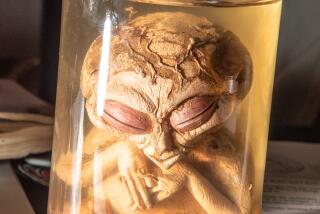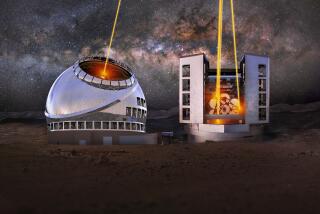‘Seeds of Doubt’ Cast at Convention : National Organization of Skeptics Exercise Their Rights
Robert Rood thinks that scanning the skies for radio transmissions from extraterrestrial civilizations, as some of his astronomer colleagues are doing, is a little like the pursuit of unicorns during the Middle Ages. It’s a “plausible” pursuit, it’s a “useful” idea and it’s based on some doubtful assumptions, he said.
Behind him, in the conference hall of the Pasadena Center, flashes a slide of a woman with a supine unicorn, its head cradled in her lap. “There’s this hope that somehow extraterrestrial civilizations will help us get over the difficulties of our own society,” he said to the tittering audience.
‘Seeds of Doubt’
Rood, professor of astronomy at the University of Virginia, was giving the people what they presumably wanted. Speaking Friday at the annual conference of the Committee for the Scientific Investigation of Claims of the Paranormal, a national organization of skeptics, he sought to “cast some seeds of doubt” regarding the international network of Search for Extraterrestrial Intelligence, which is listening for intergalactic radio transmissions.
Such probes into outer space by astronomers have been going on for 27 years without a recognizable intergalactic peep in response. The National Aeronautics and Space Administration is seeking $75 million to mount a stepped-up effort.
Two scientists who have participated in the activities, sometimes wincing at Rood’s jabs, defended their beliefs in extraterrestrial life. It is a matter of overwhelming probabilities, they said, that other planets in the universe have life forms as advanced as ours.
“We’re not looking for unicorns but something we know very well exists--evidence of another technology,” said Jill Tarter, research astronomer at University of California, Berkeley.
Pseudo-Scientific Notions
The committee, whose members include scientists and conjurers, is used to taking on controversies, both big and small. It is considered the nation’s leading debunker of pseudo-scientific notions, having attacked such claims as the Bermuda Triangle, the Loch Ness monster, the Shroud of Turin, as well as astrologers, poltergeists and faith healers. Its two-day conference drew more than 1,000 people.
On Friday, the committee’s leadership challenged those who practice “trans-channeling” to subject their purported powers to scientific tests.
“We challenge them to submit to scientific experiments in a laboratory under controlled conditions,” committee Chairman Paul Kurtz said at a press conference.
Trans-channeling is a recent spiritualist fad. Actress Shirley MacLaine has used channelers to look at her “past lives.” Others have used the practice to “communicate” with, among others, a 35,000-year-old man and John Lennon.
“What we are dealing with here is fuzz mixed with goo,” said Kurtz, citing a recent University of Chicago survey indicating that 42% of American adults claim to have had contact with dead people.
In an interview, Rood hastily denied that Search for Extraterrestrial Intelligence activities were similar to paranormal tricks. “They’re doing good scientific work, using scientific principles,” he said. “I don’t mean at all to pooh-pooh what they’re doing.”
Conclusion Challenged
But he challenged his colleagues’ conclusion that life must exist elsewhere in the universe because it exists on Earth.
Both Tarter and Frank D. Drake, dean of natural sciences at University of California, Santa Cruz, contend that all the preconditions for life on Earth--a nearby sun and the chemical “building blocks” of life--exist elsewhere.
“Life should be abundant in the universe,” said Drake, who has estimated that the number of planetary bodies in the universe where life could exist amounts to a 1 with 22 zeroes after it.
Tarter added that life on Earth appeared almost as soon as it possibly could have, suggesting a cosmic inclination toward creativity.
“From an astronomer’s point of view, life happened as soon as it could,” she said. “The planet was solid and cool at most for .3 billion years, when the first life forms appeared.” The earth is estimated to be 4.5 billion years old.
She said scientists at radio listening posts face a near-impossible task in sorting out meaningful signals from “cosmic noise pollution” produced by natural sources of radiation. “It’s a cosmic haystack out there, and we’re looking for a needle,” she said.
But Rood speculated that the creation of life on Earth may have been a “fluke” based on the proximity of a large moon. Recent scientific speculation suggests that life on Earth began in tidal pools, which were filled and emptied with regularity by lunar ocean tides. If, as some scientists contend, the moon is a “captured” body--a passing asteroid that came under Earth’s gravitational sway--then “the probability of that happening (elsewhere) is extremely small,” he said.
More to Read
Sign up for Essential California
The most important California stories and recommendations in your inbox every morning.
You may occasionally receive promotional content from the Los Angeles Times.










